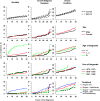Long-term outcomes in survivors of neuroblastoma: a report from the Childhood Cancer Survivor Study
- PMID: 19648511
- PMCID: PMC2728747
- DOI: 10.1093/jnci/djp230
Long-term outcomes in survivors of neuroblastoma: a report from the Childhood Cancer Survivor Study
Abstract
Background: The 5-year survival rate for individuals with neuroblastoma is approaching 70%. Few data exist, however, on the long-term outcomes of these patients, who are often treated at a very young age.
Methods: Outcome data were obtained for 954 5-year neuroblastoma survivors who were diagnosed in 1970-1986 and enrolled in the Childhood Cancer Survivor Study (CCSS). Late mortality, second malignant neoplasms, and chronic health conditions were analyzed in relation to treatment factors using Poisson regression models and their modification with generalized estimating equations. Neuroblastoma survivors were compared with a cohort of 3899 siblings of CCSS participants for risk of chronic health conditions and selected sociodemographic outcomes. All statistical tests were two-sided.
Results: Six percent of patients died more than 5 years after their diagnosis (standardized mortality ratio = 5.6; 95% confidence interval [CI] = 4.4 to 6.9). The most common causes of death were disease recurrence (n = 43) and second malignant neoplasms (n = 13). The cumulative incidence of second malignant neoplasms was 3.5% at 25 years and 7.0% at 30 years after diagnosis. Compared with the sibling cohort, survivors had an increased risk of selected chronic health conditions (risk ratio [RR] = 8.3; 95% CI = 7.1 to 9.7) with a 20-year cumulative incidence of 41.1%. The most prevalent outcomes involved the neurological, sensory, endocrine, and musculoskeletal systems, with 20-year cumulative incidences of 29.8%, 8.6%, 8.3%, and 7.8%, respectively. Neuroblastoma survivors who were treated with multimodality therapy were more likely to develop a chronic health condition than survivors treated with surgery alone (RR = 2.2; 95% CI = 1.6 to 3.0). Neuroblastoma survivors were less likely than siblings to have ever been employed (P = .04) or to be married (P < .001) and had a lower personal income (P = .009).
Conclusions: Neuroblastoma survivors have an increased rate of mortality and second malignant neoplasms, relative to the age- and sex-comparable US population, and of chronic health conditions, relative to their siblings, which underscores the need for long-term medical surveillance.
Figures


Comment in
-
The legacy of cancer therapy in children.J Natl Cancer Inst. 2009 Aug 19;101(16):1105-7. doi: 10.1093/jnci/djp238. Epub 2009 Jul 31. J Natl Cancer Inst. 2009. PMID: 19648512 No abstract available.
References
-
- Surveillance, Epidemiology, and End Results (SEER) Program, National Cancer Institute, Division of Cancer Prevention and Control, Surveillance Program, Cancer Statistics Branch, registry data 1975–2000. www.seer.cancer.gov. Accessed September 15, 2008.
-
- Maris JM, Hogarty MD, Bagatell R, Cohn SL. Neuroblastoma. Lancet. 2007;369(9579):2106–2120. - PubMed
-
- Matthay KK, Villablanca JG, Seeger RC, et al. Treatment of high-risk neuroblastoma with intensive chemotherapy, radiotherapy, autologous bone marrow transplantation, and 13-cis-retinoic acid. Children's Cancer Group. N Engl J Med. 1999;341(16):1165–1173. - PubMed
-
- Oeffinger KC, Mertens AC, Sklar CA, et al. Chronic health conditions in adult survivors of childhood cancer. N Engl J Med. 2006;355(15):1572–1582. - PubMed
-
- Zebrack BJ, Zevon MA, Turk N, et al. Psychological distress in long-term survivors of solid tumors diagnosed in childhood: a report from the Childhood Cancer Survivor Study. Pediatr Blood Cancer. 2007;49(1):47–51. - PubMed
Publication types
MeSH terms
Grants and funding
LinkOut - more resources
Full Text Sources
Medical

